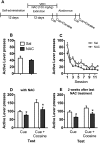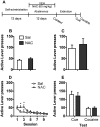Chronic N-acetylcysteine during abstinence or extinction after cocaine self-administration produces enduring reductions in drug seeking
- PMID: 21303920
- PMCID: PMC3083102
- DOI: 10.1124/jpet.111.179317
Chronic N-acetylcysteine during abstinence or extinction after cocaine self-administration produces enduring reductions in drug seeking
Abstract
The cysteine prodrug N-acetylcysteine (NAC) has been shown to reduce reinstatement of cocaine seeking by normalization of glutamatergic tone. However, enduring inhibition of cocaine seeking produced by NAC has not been explored under different withdrawal conditions. Thus, the present study determined whether chronic NAC administered during daily extinction training or daily abstinence after withdrawal from cocaine self-administration would reduce cocaine seeking. Rats self-administered intravenous cocaine during daily 2-h sessions for 12 days, followed by daily extinction or abstinence sessions. During this period, rats received daily injections of saline or NAC (60 or 100 mg/kg). Subsequently, rats were tested for cocaine seeking via conditioned cue, cue + cocaine-primed, and context-induced relapse. Chronic NAC administration blunted cocaine seeking under multiple experimental protocols. Specifically, NAC attenuated responding during cue and cue + cocaine-primed reinstatement tests after extinction and context, cue, and cue + cocaine relapse tests after abstinence. Protection from relapse by NAC persisted well after treatment was discontinued, particularly when the high dose was combined with extinction trials. The finding that NAC reduced cocaine seeking after drug treatment was discontinued has important implications for the development of effective antirelapse medications. These results support recent preclinical and clinical findings that NAC may serve as an effective treatment for inhibiting relapse in cocaine addicts.
Figures





Similar articles
-
N-acetylcysteine amide (AD4) reduces cocaine-induced reinstatement.Psychopharmacology (Berl). 2016 Sep;233(18):3437-48. doi: 10.1007/s00213-016-4388-5. Epub 2016 Jul 28. Psychopharmacology (Berl). 2016. PMID: 27469021
-
The effects of Pavlovian cue extinction and ceftriaxone on cocaine relapse after abstinence.Drug Alcohol Depend. 2019 Apr 1;197:83-86. doi: 10.1016/j.drugalcdep.2019.01.005. Epub 2019 Feb 13. Drug Alcohol Depend. 2019. PMID: 30784953 Free PMC article.
-
Chronic restraint stress during withdrawal increases vulnerability to drug priming-induced cocaine seeking via a dopamine D1-like receptor-mediated mechanism.Drug Alcohol Depend. 2018 Jun 1;187:327-334. doi: 10.1016/j.drugalcdep.2018.03.024. Epub 2018 Apr 22. Drug Alcohol Depend. 2018. PMID: 29705546 Free PMC article.
-
Animal Models of Drug Relapse and Craving after Voluntary Abstinence: A Review.Pharmacol Rev. 2021 Jul;73(3):1050-1083. doi: 10.1124/pharmrev.120.000191. Pharmacol Rev. 2021. PMID: 34257149 Free PMC article. Review.
-
Forced abstinence model of relapse to study pharmacological treatments of substance use disorder.Curr Drug Abuse Rev. 2009 May;2(2):184-94. doi: 10.2174/1874473710902020184. Curr Drug Abuse Rev. 2009. PMID: 19630748 Free PMC article. Review.
Cited by
-
The Potential of N-Acetyl-L-Cysteine (NAC) in the Treatment of Psychiatric Disorders.CNS Drugs. 2022 May;36(5):451-482. doi: 10.1007/s40263-022-00907-3. Epub 2022 Mar 22. CNS Drugs. 2022. PMID: 35316513 Free PMC article. Review.
-
Role of prefrontal cortex in the extinction of drug memories.Psychopharmacology (Berl). 2019 Jan;236(1):463-477. doi: 10.1007/s00213-018-5069-3. Epub 2018 Nov 3. Psychopharmacology (Berl). 2019. PMID: 30392133 Review.
-
Potential role of N-acetylcysteine in the management of substance use disorders.CNS Drugs. 2014 Feb;28(2):95-106. doi: 10.1007/s40263-014-0142-x. CNS Drugs. 2014. PMID: 24442756 Free PMC article. Review.
-
Hypothesizing that, A Pro-Dopamine Regulator (KB220Z) Should Optimize, but Not Hyper-Activate the Activity of Trace Amine-Associated Receptor 1 (TAAR-1) and Induce Anti-Craving of Psychostimulants in the Long-Term.J Reward Defic Syndr Addict Sci. 2016;2(1):14-21. doi: 10.17756/jrdsas.2016-023. Epub 2016 Jun 29. J Reward Defic Syndr Addict Sci. 2016. PMID: 28317038 Free PMC article.
-
Thinking outside the cleft to understand synaptic activity: contribution of the cystine-glutamate antiporter (System xc-) to normal and pathological glutamatergic signaling.Pharmacol Rev. 2012 Jul;64(3):780-802. doi: 10.1124/pr.110.003889. Pharmacol Rev. 2012. PMID: 22759795 Free PMC article. Review.
References
-
- Achat-Mendes C, Anderson KL, Itzhak Y. (2007) Impairment in consolidation of learned place preference following dopaminergic neurotoxicity in mice is ameliorated by N-acetylcysteine but not D1 and D2 dopamine receptor agonists. Neuropsychopharmacology 32:531–541 - PubMed
-
- Baker DA, McFarland K, Lake RW, Shen H, Tang XC, Toda S, Kalivas PW. (2003a) Neuroadaptations in cystine-glutamate exchange underlie cocaine relapse. Nat Neurosci 6:743–749 - PubMed
-
- Baker DA, McFarland K, Lake RW, Shen H, Toda S, Kalivas PW. (2003b) N-acetyl cysteine-induced blockade of cocaine-induced reinstatement. Ann NY Acad Sci 1003:349–351 - PubMed
Publication types
MeSH terms
Substances
Grants and funding
LinkOut - more resources
Full Text Sources
Medical

